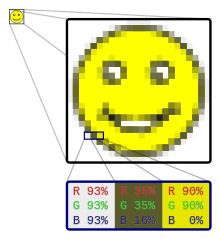
Back رسوميات نقطية Arabic Rastr təsvir Azerbaijani Растравая графіка Byelorussian Растравая графіка BE-X-OLD Растерна графика Bulgarian র্যাস্টার গ্রাফিক্স Bengali/Bangla Rasterska grafika BS Mapa de bits Catalan Rastrová grafika Czech Rasterbillede Danish
This article needs additional citations for verification. (November 2016) |

In computer graphics and digital photography, a raster graphic represents a two-dimensional picture as a rectangular matrix or grid of pixels, viewable via a computer display, paper, or other display medium. A raster is technically characterized by the width and height of the image in pixels and by the number of bits per pixel.[citation needed] Raster images are stored in image files with varying dissemination, production, generation, and acquisition formats.
The printing and prepress industries know raster graphics as contones (from continuous tones). In contrast, line art is usually implemented as vector graphics in digital systems.[1]

Many raster manipulations map directly onto the mathematical formalisms of linear algebra, where mathematical objects of matrix structure are of central concern.
- ^ "Patent US6469805 – Post raster-image processing controls for digital color image printing". Google.nl. Archived from the original on 5 December 2014. Retrieved 30 November 2014.
© MMXXIII Rich X Search. We shall prevail. All rights reserved. Rich X Search